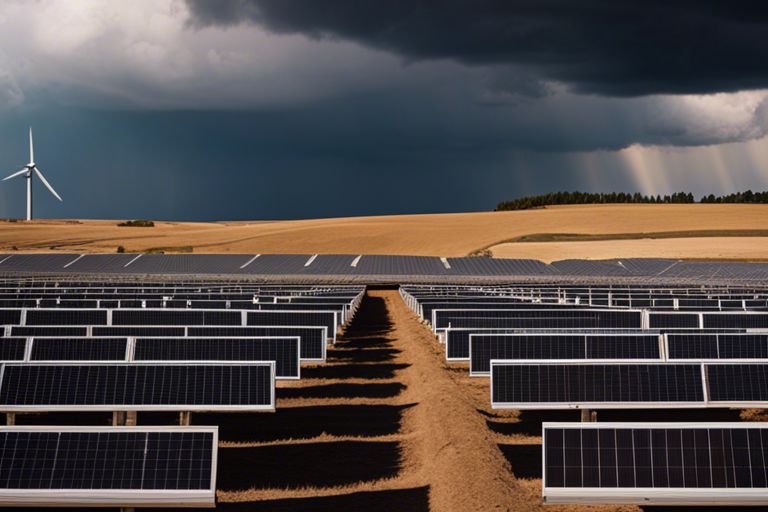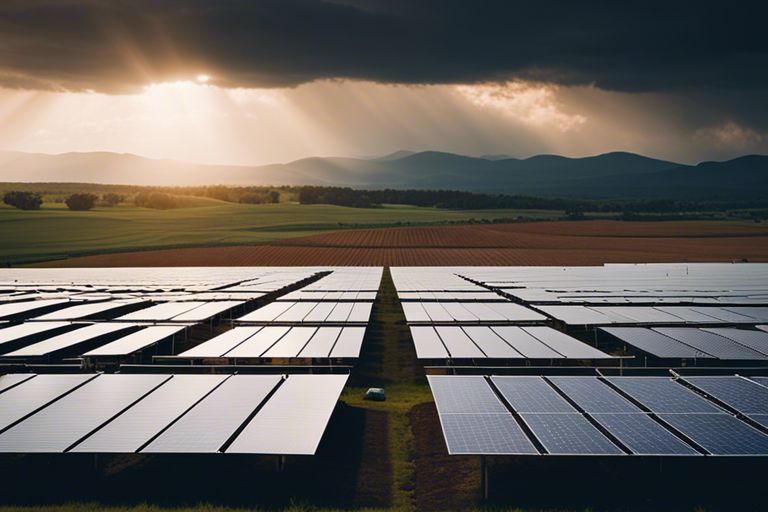Most people are aware of the benefits of solar energy – it’s sustainable, reduces electricity bills, and lowers your carbon footprint. However, it’s important to understand the biggest drawback to solar energy as well. In this blog post, we will explore the key limitation of solar power and how it may impact your decision to switch to solar energy for your home or business.

Key Takeaways:
- Intermittency: Solar energy generation is dependent on sunlight, making it intermittent and not available at night or during cloudy weather.
- Energy Storage: The need for efficient and cost-effective energy storage solutions to store excess energy generated during the day for use at night or on cloudy days.
- Environmental Impact: The manufacturing and disposal of solar panels can have environmental impacts, such as the use of toxic materials and greenhouse gas emissions.
- Land Use: Solar farms require significant amounts of land, which can lead to habitat disruption, land use conflicts, and the loss of agricultural or natural spaces.
- Cost: The initial cost of setting up solar panels and the infrastructure for solar energy generation can be high, although it has been decreasing in recent years.

The Intermittency Problem
Before delving into the drawbacks of solar energy, have you ever wondered about the challenges associated with harnessing sunlight as a primary energy source? If you’re curious to learn more, check out this insightful article on What Are The Main Disadvantages Of Solar Energy?
The Unreliability of Solar Energy
With solar energy being dependent on sunlight, one of the primary drawbacks is its intermittency. While the sun is an abundant source of renewable energy, its availability fluctuates based on time of day, weather conditions, and seasons. This poses a challenge in consistently meeting energy demands, especially during nighttime or cloudy days when solar panels cannot generate electricity at full capacity.
The Impact on Grid Stability
Energy grids rely on a stable and balanced power supply to meet the varying demands of consumers. The intermittent nature of solar energy can disrupt grid stability, as sudden changes in solar output require quick adjustments from other energy sources like fossil fuels or storage systems to maintain a steady flow of electricity. This variability can lead to issues like overloading or underutilization of grid infrastructure, impacting overall efficiency and reliability.
Intermittency in solar energy underscores the need for innovative solutions to integrate renewable sources seamlessly into the existing energy grid, ensuring a sustainable and reliable power supply for the future.
The High Upfront Costs of Solar Energy
Any discussion about the drawbacks of solar energy inevitably leads to the high upfront costs associated with installing a solar power system. The initial investment in solar panels can be significant, deterring many homeowners from making the switch to solar energy.
The Cost of Solar Panels
On the surface, the cost of solar panels may seem prohibitive. However, it’s imperative to consider the long-term benefits and savings that come with generating your own clean energy. While the upfront costs may be a barrier, over time, you can significantly reduce or even eliminate your electricity bills, making solar energy a wise investment in the long run.
The Cost of Installation and Maintenance
One of the major factors contributing to the high upfront costs of solar energy is the installation and maintenance expenses. Hiring professionals to install a solar power system can add to the overall investment. Additionally, ongoing maintenance costs should be factored in to ensure the efficiency and longevity of your solar panels.
Plus, advancements in technology have made solar panels more durable and efficient, reducing the maintenance requirements over time. With proper care and maintenance, your solar power system can last for decades, providing you with clean and renewable energy for years to come.
Energy Storage Challenges
Your Solar Energy: Benefits and Drawbacks article highlights the significant energy storage challenges that come with solar power generation. As solar energy relies on the availability of sunlight, storing excess energy for use during periods of low sunlight is crucial to ensure a continuous power supply.
The Limitations of Battery Technology
Limitations in battery technology pose a challenge for storing solar energy efficiently. While advancements have been made in battery storage solutions, such as lithium-ion batteries commonly used in residential solar systems, these batteries have limitations in terms of capacity and longevity. As solar energy systems grow in popularity and size, the need for more advanced and scalable energy storage solutions becomes increasingly pressing.
The Need for Advanced Energy Storage Solutions
Advanced energy storage solutions are crucial to overcome the limitations of current battery technology and maximize the potential of solar energy. Here are some key points to consider:
- Scalability: Current battery technologies may lack scalability, making it challenging to store large amounts of solar energy efficiently.
- Longevity: Battery degradation over time affects the overall efficiency and lifespan of energy storage systems, requiring frequent replacements.
Energy storage technologies play a vital role in enhancing the reliability and sustainability of solar power systems. By addressing the challenges of energy storage, we can unlock the full potential of solar energy as a clean and renewable power source for the future.

Land Requirements and Environmental Concerns
The Space Needed for Solar Farms
Not only do solar panels require a significant amount of space to generate electricity efficiently, but large-scale solar farms can take up valuable land that could otherwise be used for agriculture or natural habitats. This dilemma raises concerns about the trade-off between renewable energy production and land usage.
The Impact on Ecosystems and Wildlife
Any disruption to the natural landscape can have a cascading effect on ecosystems and wildlife. The installation of solar panels can fragment habitats, interfere with migration patterns, and potentially harm local biodiversity. Balancing the need for clean energy with the preservation of ecosystems is a complex challenge that requires thoughtful planning and consideration.
Environmentalists are increasingly concerned about the potential negative impacts of large solar farms on local flora and fauna. The conversion of natural landscapes into solar fields can displace species, disrupt ecological processes, and decrease overall biodiversity. It is crucial to assess these risks and implement measures to mitigate harm to the environment.
Energy Density and Efficiency
The Low Energy Density of Solar Energy
Unlike fossil fuels such as coal or oil, solar energy has low energy density. This means that a large surface area is required to capture a significant amount of energy. Even in sunny regions, solar panels need to cover a considerable amount of space to produce enough electricity to power a typical household. This can be a limiting factor for many people, especially those living in urban areas with limited roof space.
The Efficiency of Solar Panels
An important factor to consider when evaluating solar energy is the efficiency of solar panels. Solar panels have made great strides in efficiency in recent years, but they still have limitations. Any inefficiencies in converting sunlight into electricity can reduce the overall output of a solar energy system. Factors such as shading, dirt buildup, and the angle of installation can all impact the efficiency of solar panels.
Solar panels typically have an efficiency rating between 15-22%, which means that only a portion of the sunlight that hits the panels is converted into usable electricity. Improving the efficiency of solar panels is an ongoing area of research and development in the solar energy industry.
Policy and Regulation Hurdles
The Lack of Standardized Policies
Despite the advancements in solar technology, one of the most significant drawbacks to solar energy is the lack of standardized policies regarding its implementation. Each state, and even each municipality, may have different regulations and incentives in place, making it confusing for consumers and businesses to navigate the solar market. This lack of consistency can deter potential solar adopters from investing in renewable energy systems, as they may face barriers or complications due to varying policies.
The Need for Regulatory Frameworks
The implementation of solar energy systems requires a clear regulatory framework to ensure efficient and smooth operations. To address this need, regulatory bodies must work towards establishing standardized processes for permitting, interconnection, and grid integration of solar systems. Without clear guidelines and oversight, the process of going solar can be riddled with delays and uncertainties, hindering the widespread adoption of solar energy.
Regulation plays a crucial role in shaping the solar energy landscape. By establishing transparent and consistent rules, regulations can help streamline the adoption process, reduce uncertainties, and create a level playing field for all stakeholders involved in the solar industry. Effective regulation can foster innovation, drive down costs, and accelerate the transition to a clean energy future powered by solar.
Summing up
With these considerations in mind, the biggest drawback to solar energy seems to be the initial high cost of installation. While solar panels have become more affordable over the years, the upfront investment can still be a barrier for many people. This cost factor may deter some individuals from making the switch to solar energy, despite the long-term savings and environmental benefits it offers.
If you want to explore more in-depth discussions about the drawbacks of solar energy, you can visit this serious question. What if any, are the negatives to using solar panels? thread on Reddit to hear firsthand experiences and perspectives from the solar community.
FAQ
Q: What is the biggest drawback to solar energy?
A: The biggest drawback to solar energy is its intermittency. Solar power generation is dependent on sunlight, so solar panels can only produce electricity during the day and require energy storage solutions or backup power sources for night-time or cloudy days.
Q: Are there any other limitations of solar energy?
A: Yes, another limitation of solar energy is the high upfront costs associated with installing solar panels and related equipment. While solar energy can save money in the long run due to lower operating costs, the initial investment required can be a barrier for some homeowners and businesses.
Q: Is there any environmental impact associated with solar energy?
A: While solar energy is a clean and renewable energy source, the manufacturing process of solar panels and the disposal of old panels can have environmental impacts. The production of solar panels generates emissions and waste, and improper disposal of panels can lead to pollution. However, these environmental impacts are generally considered minimal compared to the benefits of using solar energy.
